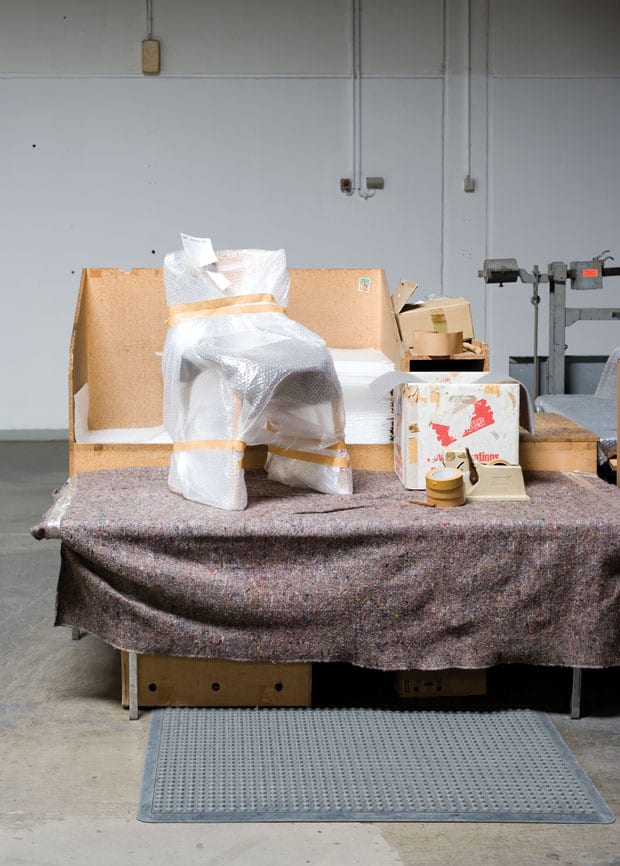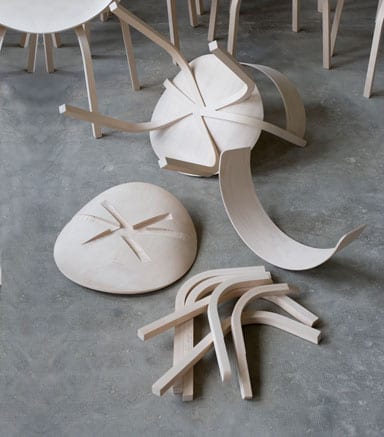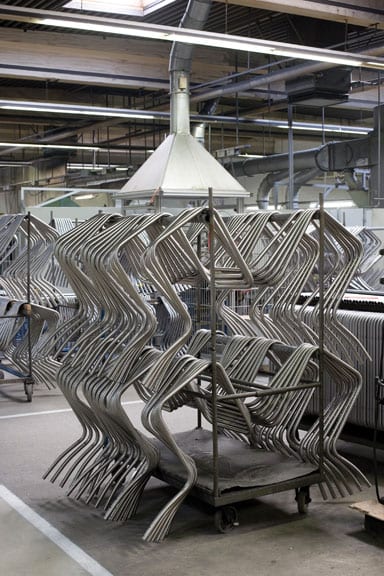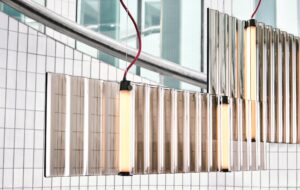
words Sophie Lovell
Sophie Lovell takes a privileged peek behind the scenes at Germany’s oldest industrial furniture maker.
It takes five and a half hours to drive from Berlin to the Thonet factory, a journey into the beech forests at the heart of Germany, through small, well-kept villages, past farmhouses on hillsides and little factories tucked into valleys. The Thonet plant consists of a collection of low buildings straddling a railway siding occupied by wagonloads of locally harvested tree trunks. On top of one building stands a giant wooden chair – the wooden chair that started it all.
Thonet, one of Germany’s oldest furniture manufacturers, turns 190 next year. The family-run company has brought us some of the most memorable chairs of the modern age from designers including Mart Stam, Marcel Breuer, Mies van der Rohe, Le Corbusier, Verner Panton, Alfredo Häberli and Piero Lissoni. It owes its success and its survival to a combination of experimentation, prescient design choices and an eclectic combination of production techniques. Thonet’s products are hybrids of industrial processes and highly skilled handcraft made in a factory where steam-age technology rubs shoulders with robots.
The Thonet family tends to keep itself to itself most of the time, but the day we visited they were preparing for their first ever open day. The brothers Claus (now retired), Peter and Phillip Thonet, and their wives Anke-Maria, Vivie and Ulrike, were busy with new managing director Roland Ohnacker (the first non-family member in this position in the firm’s history) and the rest of the 70-odd staff tidying up the factory in preparation for the arrival of a couple of thousand guests. In the modern wood workshop, piles of chair parts were stacked neatly between five-way milling machines, alongside hundreds of forms for shaping plywood and tables with blocks of wood and sandpaper for the hand finishing of every component. Ducking through another doorway was like jumping 150 years back in time. Here two men wrestled with beech rods in the steam workshop: bending, twisting and clamping them into impossible shapes. The rods are baked in ancient-looking steam ovens and the clamps and moulds for different bentwood furniture parts are scattered around the gloomy space like so many torture instruments.
The company was founded in Boppard am Rhein, Germany, in 1819 by an experimental woodworker named Michael Thonet. His great breakthrough came 40 years later in Vienna with Thonet’s No 14 chair, the so-called “Viennese coffee house chair”, which bridged the gap between pre-industrial fine handcraft and functional, mass-produced modernism. This delicate-looking, yet remarkably robust, curved-backed classic is as familiar as a Coca-Cola bottle, and it made Thonet a success. In its 150 years of production, more than 60 million examples of the No 14 (now known as the 214) have been sold.
Across the railway tracks, the Thonet metal workshops turn out the company’s second big technical breakthrough: tubular steel furniture, which first went into production with Bauhaus pieces in the late 1920s. The air here was thick with the smell of steel and a technology mix worthy of a Terry Gilliam film. Huge machines for stamping, polishing and pressing metal run next to nimble robot arms turning, bending and shaping the tubes in a strange high-speed parody of the two men in the steam workshop. But next to the machines stand workers, some with simple tools: a set square and a hammer, for example, to check that each robot-generated cantilever chair frame is as perfectly balanced as it should be. Other workmen oversee the chroming process. There seems to be a harmony here between hand, machine and microchip that does not discriminate – the job is done by whoever or whatever can do it best. The product, not process, is king.
Some 100,000 products are made each year here at Frankenberg. For all its foundation in tradition, the company has learned that change is essential to survival. The early “mass-production” techniques that were the key to Thonet’s original success have long been superseded and labour is considerably more expensive than it was 150 years ago, which means that their once-affordable “democratic” products are now expensive to produce. But instead of trying to compete in the mass-market and going to the wall, as so many other European companies have done, Thonet has concentrated on quality at the expense of volume and focused on particular niches. The technology has advanced – the robot bending steel in the metalwork factory is state-of-the-art and there’s another spraying lacquer in the paint shop, as well as plenty of computer design in the research and development area – but all this goes hand in hand with the considerable manual skills and time required to steam, bend and form the local beech wood or polish, bend and treat steel or stitch leather and wickerwork for seating.
What makes Thonet special, says British designer and the company creative director James Irvine, is its “strong progressive history” and its “strange moral right to work with certain technologies such as bent wood and steel”. The patents protecting many of its early products have long since elapsed and many have been copied in their thousands, but the name Thonet still implies quality. “Thonet is the Cartier or Rolls Royce of chairs,” gushes Irvine, although it’s clear that designers who are invited to work for the company are acutely aware of its heritage. Irvine has just designed a new bar stool for the contract range in leather and steel, an element missing in the product range. “It’s nice to do a product that the Bauhaus forgot to do,” says Irvine. “It quite plainly fits into a category that has been around for years.” A loud “protagoniste” piece for Thonet would be out of the question, says Irvine.
The Thonet wood-workshop is currently filled with the curved components of the 404, the new “classic” chair designed by young German designer Stefan Diez. Diez says he took the 214 as inspiration for the 404, which is also bent wood, with legs made from a kind of ply that is bent in big sheets and cut into pieces by machine. After being sanded by hand, the legs fit together like a Chinese wooden puzzle under the thickened seat of the chair, without a single screw or nail, to structure, stability and backrest all in one movement.
One leaves the company metal-workshop via the paint shop and then out into the sunshine. The rest of the factory site appears to be a paddock filled with grazing horses and groups of trees. It is a peaceful place and although it is a complete contradiction to talk about industry being in harmony with nature, one can’t help feeling that the principle of handcraft, with a little help from robots, isn’t such a bad direction to be going in.


















